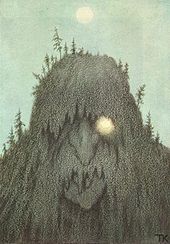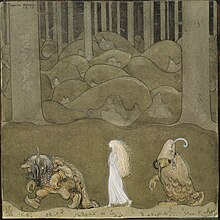😜😛😚😋💪😁💜💛💚💙💋💋💋...
Numerous tales are recorded about trolls in which they are frequently described as being extremely old, very strong, but slow and dim-witted, and are at times described as man-eaters and as turning to stone upon contact with sunlight. However, trolls are also attested as looking much the same as human beings, without any particularly hideous appearance about them, but living far away from human habitation and generally having "some form of social organization"—unlike the rå and näck, who are attested as "solitary beings". According to John Lindow, what sets them apart is that they are not Christian, and those who encounter them do not know them. Therefore, trolls were in the end dangerous, regardless of how well they might get along with Christian society, and trolls display a habit of bergtagning ('kidnapping'; literally "mountain-taking") and overrunning a farm or estate.
Lindow states that the etymology of the word "troll" remains uncertain, though he defines trolls in later Swedish folklore as "nature beings" and as "all-purpose otherworldly being[s], equivalent, for example, to fairies in Anglo-Celtic traditions". They "therefore appear in various migratory legends where collective nature-beings are called for". Lindow notes that trolls are sometimes swapped out for cats and "little people" in the folklore record.
A Scandinavian folk belief that lightning frightens away trolls and jötnar appears in numerous Scandinavian folktales, and may be a late reflection of the god Thor's role in fighting such beings. In connection, the lack of trolls and jötnar in modern Scandinavia is sometimes explained as a result of the "accuracy and efficiency of the lightning strokes". Additionally, the absence of trolls in regions of Scandinavia is described in folklore as being a "consequence of the constant din of the church-bells". This ringing caused the trolls to leave for other lands, although not without some resistance; numerous traditions relate how trolls destroyed a church under construction or hurled boulders and stones at completed churches. Large local stones are sometimes described as the product of a troll's toss. Additionally, into the 20th century, the origins of particular Scandinavian landmarks, such as particular stones, are ascribed to trolls who may, for example, have turned to stone upon exposure to sunlight.
Lindow compares the trolls of the Swedish folk tradition to Grendel, the supernatural mead hall invader in the Old English poem Beowulf, and notes that "just as the poem Beowulf emphasizes not the harrying of Grendel but the cleansing of the hall of Beowulf, so the modern tales stress the moment when the trolls are driven off."
Smaller trolls are attested as living in burial mounds and in mountains in Scandinavian folk tradition. In Denmark, these creatures are recorded as troldfolk ("troll-folk"), bjergtrolde ("mountain-trolls"), or bjergfolk ("mountain-folk") and in Norway also as troldfolk ("troll-folk") and tusser. Trolls may be described as small, human-like beings or as tall as men depending on the region of origin of the story.
In Norwegian tradition, similar tales may be told about the larger trolls and the Huldrefolk ("hidden-folk"), yet a distinction is made between the two. The use of the word trow in Orkney and Shetland, to mean beings which are very like the Huldrefolk in Norway, may suggest a common origin for the terms. The word troll may have been used by pagan Norse settlers in Orkney and Shetland as a collective term for supernatural beings who should be respected and avoided rather than worshipped. Troll could later have become specialized as a description of the larger, more menacing Jötunn-kind whereas Huldrefolk may have developed as the term for smaller trolls.
John Arnott MacCulloch posited a connection between the Old Norse vættir and trolls, suggesting that both concepts may derive from spirits of the dead.
"Troll," a Norwegian research station in Antarctica, is so named because of the rugged mountains which stand around that place like trolls. It includes a ground station which tracks satellites in polar orbit.




No comments:
Post a Comment